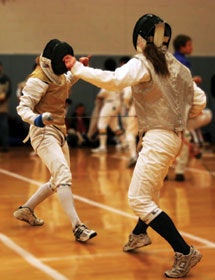U.S. success in Beijing has helped fuel a prep fencing movement.

"Memorial students know we exist, and the general public is starting to take notice. We get acknowledged at the end-of-the-season pep rally, and we appreciate that, but it took us awhile to get to this point," says Sampon, an art teacher and former elite fencer who started a fencing club with just six students in the late 1970s. Participation doubled the next semester, and by 1980, Catholic Memorial was involved in fencing's first Midwest High School Championship - an event now known as the Great Lakes High School Fencing Conference Championship. Today, the school boasts the only varsity fencing team in Wisconsin, with 21 girls and 20 boys who practice three days a week between mid-September and early February, using just one-half of a gymnasium or the school's cafeteria. The Crusaders will host the GLHSFC Championship later this month, as varsity teams from nine Indiana and Illinois high schools join Catholic Memorial to vie for a conference title that has become more coveted with each passing year.
Thanks to the U.S. fencing team's remarkable six-medal performance at the 2008 Olympic Games, fencing is standing tall right now. "All sports got a bit of a bump from the Olympics," says Cecil Bleiker, media services director for six of the United States Olympic Committee's national governing bodies, including the United States Fencing Association. "But the ones that were televised more got a bigger bump."
One of those sports is fencing, among only four that have been featured at every modern-day Olympics since 1896. Team USA's medal count in Beijing included a clean sweep in women's sabre, earning fencing some unexpected but welcome prime-time TV coverage. The team's success, built on momentum U.S. fencers generated in Athens in 2004, has spurred interest in fencing at all levels. Milwaukee's Caliburn Fencing Club, for example, was training its largest beginner class ever in November, while the National Federation of State High School Associations reported record high participation numbers in varsity fencing for both boys (1,966) and girls (1,827) in 2006-2007. And at least 44 NCAA colleges and universities now sponsor fencing teams or clubs, according to USFA.
Barbara Lynch, longtime fencing coach at Morris Hills High School in Rockaway, N.J., has likewise witnessed fencing's sharp rise. "I've seen the sport grow, from Atlanta through the Athens Olympics and now Beijing," she told Morristown's Daily Record last month. "All the coaches I talk to have kids who've come up to them saying, 'I saw fencing in the Olympics, show me.' "
Some people involved in the sport also attribute at least part of its popularity growth to the success of the Pirates of the Caribbean movies - an idea that doesn't seem so far-fetched considering that more than half (55 percent) of all USFA members are younger than 15.

According to Bleiker, while interest in fencing among high school students may be high, a lack of coaching expertise and financial resources could prohibit the sport from growing beyond club status at most high schools. "The problem is that other schools don't have access to a coach who fences," Sampon says. "All of the schools that we compete against have teams run by fencers or former fencers who are now teaching in the school."
Money may prove to be an equally challenging obstacle. Sampon, who has limited Catholic Memorial's fencing team to 45 participants, estimates that it costs $750 to properly outfit a fencer with top-of-the-line protective gear and equipment. While an annual budget allocation of $2,000 from the school's athletic department helps, as does a $100-per-fencer fee to join the team, Sampon says the team also relies on dollars generated by concessions and registrations at invitationals it hosts, as well as parental support. The $100 fee helps foot the bill for a charter bus that takes Crusader fencers to six Saturday meets, often across state lines, between November and January. "You'd be surprised by what we can do with the money we have," Sampon says, adding that only a few pieces of equipment are replaced every year. "We wheel and deal sometimes, and we've got fencing connections in Russia, where we can buy some things for three-quarters of what they cost in the United States."
On the other hand, the varsity fencing team at Randolph (N.J.) High School - which evolved in 2007 out of a municipal recreation program - was, at least initially, funded completely out of parents' pockets.
Regardless of how fast high school fencing teams and leagues are forming, their rosters are stocked with inexperienced participants. Ninety-five percent of the 50 students on 2006's first-year fencing team at Lassiter High School in Marietta, Ga., for example, had never picked up a weapon before, according to Kathy Vail, vice chair of the Georgia High School Fencing League. "Kids might have no time to go to a private club," she told The Atlanta Journal-Constitution. "And it can be a little intimidating. But if they come by the cafeteria and see that the guy they sit next to in math class is doing it at practice, they think, 'I can do that.' "
"Not every one of these kids is athletic," Sampon says about his fencers, although some also are members of Catholic Memorial's football, swimming, tennis, volleyball and girls' rugby teams. "But you don't have to be a great fencer to appreciate the sport and get something out of it."
































